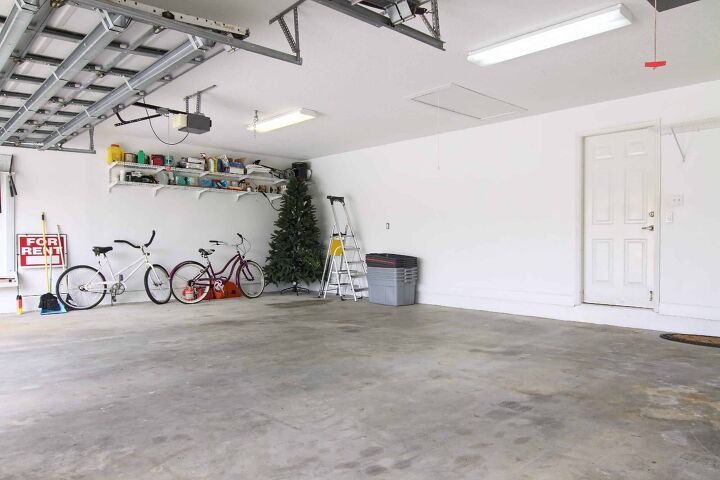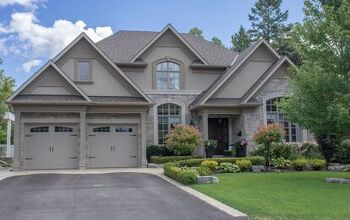What Type Of Door Between The House and Garage?

An attached garage is incredibly convenient. Having a door that provides protected and direct access from your household to the garage can be a real life-saver when there is foul weather. Many people want to install one of these doors to enjoy these benefits. Before you install a garage entry door, however, be sure you understand the exact specifications required.
The door that connects your house and garage is called a garage entry door. These doors must be fire-rated doors, made of specific materials in order to ensure they meet fire safety standards. These doors must pass all International Residential Code (IRC) requirements. This code states that all garage entry doors must be self-closing and cannot open into a bedroom.
Once you decide to take the steps to build a garage, or build an entry that connects your home to your garage, you must do some research. In addition to basic housing codes and safety measures, there are additional regulations and protocols you must follow when you install a garage entry door in your home.
Rules And Codes For Garage Entry Doors
According to the International Residential Code (IRC), the opening between the house and the garage has to be outfitted with a door that provides protection per Section R302.5.1. Now, what exactly does that mean?
This section of the code outlines all the specific guidelines required for these types of doors. Installing any one of the following door types will satisfy the requirements listed in Section R302.5.1.
- Solid wood door that is no less than 1-3/8 inch thick.
- Solid or honeycomb-core steel door, at least 1-3/8 inches thick.
- 20 Minute fire-rated door.
All of the above doors must be fitted with either an automatic-closing device or a self-closing mechanism in order to comply. These devices are put in place to limit the flow of carbon monoxide or other combustible fumes from entering into the living areas of the home.
These requirements may vary slightly depending on your particular state. Always consult your local building code before purchasing a garage entry door.
Quick Tip: If you are looking for a specific design, you may want to inquire with your local home improvement specialist. They should have a variety of style doors that are already built to code.
What is a Fire-Rated Door?
A fire-rated door is particularly designed to help prevent or slow the spread of fire, smoke, and any combustible fumes. This includes carbon monoxide gas. They are often very heavy doors made of materials such as metal or gypsum. The actual term “fire-rated” refers to the fact that the door is not supposed to combust over a certain time period in an average fire.
Fire-rated doors resist the infiltration of flames, and slow the fire for a specified time period. This allows for additional time to safely exit the structure. They can also help protect your personal assets and interior structure while firefighters work to put out the flames.
Fire-rated doors have time ratings. These designations vary. However, the standard fire-rated doors rate between 20- and 90-minute doors. Fire-rated doors are more commonly installed in commercial buildings. However, they are also one of the required options you can choose from when selecting your garage entry door.
Types of Fire-Rated Doors
While fire-rated doors are more common in commercial environments, many manufacturers sell fire-rated doors for residential settings. Depending on the company that you go with, you may have finished and unfinished exterior door options as well as a variety of styles and wood types.
Additionally, you’ll often find fire-rated doors that are either made of composite core or plywood. The most common ratings that you’ll find will start at 20 minutes and go up to at least 90 minutes.
For interior fire-rated doors, options include, but aren’t limited to, clear fire glass, obscure fire glass and solid panels. Many companies also construct customer fire-rated doors to fit within the architectural design of your home.
Why Fire-Rated Doors?
When it comes to the opening between your garage and your home, you have a few options. So, why should you consider the fire-rated variety? When fire-rated doors are properly installed, they can provide peace of mind to homeowners and reduce the likelihood of fire, smoke, and other harmful fumes from entering into your home.
However, it should be noted that even with the best fire-rated door, fire can still melt through steel. Although the door may be rated for a particular period of time, in a real-world setting, it’s possible that the heat intensity could reduce this estimate. Additionally, a fire-rated door will not be effective if it’s left open if the self-closing device is faulty.
As long as it’s used correctly, the proper use of your fire-rated door may be all that you need to protect your dwelling from fire damage. Simply closing the door in your home can be all that you need to help shield fire and smoke. This door can truly save lives.
How do I know if a door is fire-rated?
If you’ve recently moved into a home and want to verify whether or not your garage entry door is fire-rated, look for the designation fire label. If the door is fire-rated it will have either an Underwriters Laboratories (UL) or Warnock Hersey (WH) label. These labels can most often be found on the top and bottom of the door, the hinge side, or embossed into the frame.
Additional Requirements For Garage Entry Doors
In addition to the door that leads from your home into your garage, there are some additional requirements that you must adhere to in regards to this area. Again, these may vary depending on your local building codes but in general, the specifications are as follows:
- Openings around pipes, vents, cables, ducts, wires, or any other penetrations must be sealed using an approved material that resists the passage of flame and other combustible fumes.
- Large openings in the wall need materials such as radon popes and firestop collars.
- Small openings can be sealed using specialized fire-sealant products.
- The wall between the garage and the house must be separated by ½ inch of drywall.
- Drywall must be used for the ceiling if you have habitable rooms above your garage, a 5/8-inch type X (fire-rated)
- Pull-down stairs in the ceiling of a garage are required to meet the requirements of ½ inch drywall. Otherwise the must have a 20-minute fire-rating.
In case of fire, the garage needs to be specifically separated from the house by following the guidelines outlined above.
Can Garage Entry Doors Connect To A Bedroom?
In addition to making sure a garage entry door is up to code and closes properly, you also need to consider what is on the other side of the door. The International Residential Code clearly states that the garage entry door cannot open up to a room whose purpose is sleeping.
This means that you need to make sure whatever room your garage door opens up to is not a bedroom and cannot be considered a bedroom. This is perhaps why you often find the garage entry door located near the kitchen, as the code allows for this.
Typical Price Of A Garage Entry Door
A garage entry door is typically significantly more expensive than other types of doors you may have installed in your home. If you purchase a fire entry door at a popular retail shop like Home Depot or Lowe’s, you should expect to pay between $400 and $500. After reading all the specific requirements necessary for a garage entry door, however, this price tag is likely not all that shocking.
Closing It Up
Garage entry doors are very convenient, but understanding the requirements necessary to install one can be a bit overwhelming. When you prepare to install a garage entry door you should first look at all the International Residential Code requirements. This will ensure you are doing your home improvements within the proper codes and laws.
Make sure you meet all the fire safety and zoning requirements. Next, it may be a good idea to check out your local home improvement specialist store to get a door. Most major home improvement stores have garage entry doors that completely meet all the necessary requirements. This will make your job much easier.
Related Questions
Can you put a deadbolt on a fire-rated door?
You can use a deadbolt on a fire-rated door as long as you purchase one that is labeled and listed for this specific purpose.
Are there exterior fire-rated doors with glass?
Fire-rated doors with glass are more often used on the interior of the home. Still, some are suitable for garage entry doors or other exterior environments. However, they can be quite expensive when compared to standard solid wood fire-rated doors.Check Out These Garage-Related Guides

Jessica considers herself a home improvement and design enthusiast. She grew up surrounded by constant home improvement projects and owes most of what she knows to helping her dad renovate her childhood home. Being a Los Angeles resident, Jessica spends a lot of her time looking for her next DIY project and sharing her love for home design.
More by Jessica Stone

























![How To Reset A Whirlpool Cabrio Washer [In 5 Easy Steps!]](https://cdn-fastly.upgradedhome.com/media/2023/07/31/9076531/how-to-reset-a-whirlpool-cabrio-washer-in-5-easy-steps.jpg?size=350x220)

